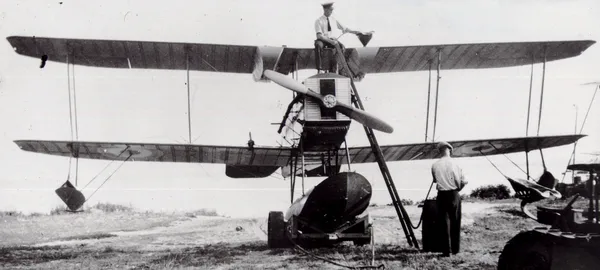552 AVS (Total: 10, Canadian: 10, Group 0)
Avro 552 AVS

Avro 552A Viper SS Patrol, RCAF.
Avro 552A Viper SS Patrol AVL (5) Reg. Nos. G-CYFT "� G-CYFX, Avro 552A Viper TS Patrol AVS (9) Reg. Nos. G-CYGB to G-CYGJ, for a total of 14 aircraft.
The Avro 552 was a British light biplane aircraft produced in the early 1920s. It was another attempt by Avro to sell a derivative of the wartime 504 to the civil market. In this case, the company took advantage of the large number of war-surplus Wolseley Viper engines left over from Royal Aircraft Factory S.E.5a production. In 1921, one of these was married to a standard 504K airframe for evaluation under the designation Avro 551. Trials proved encouraging, but an extra fuel tank was installed in the upper wing as a result of the Viper's higher rate of fuel consumption, and changes were also made to the aileron design.
This configuration went into production as the 552, with the Argentine Navy purchasing 12 examples of a float-equipped version, the 552A, which served as trainers until 1927. Two similar machines were purchased by Bulgaria.
In 1924, the Royal Canadian Air Force arranged for Canadian Vickers to purchase a licence to produce five landplanes and nine seaplane examples for use in forestry patrol. These differed from British-built aircraft by the use of U.S. Naval Aircraft Factory floats, and increased fuel tankage for extended range. One of the license-built seaplanes was fitted with a Wright engine and known in Canadian service as the Avro Wright. Licensed production was also undertaken by C.B. Field of Kingswood Knoll, Surrey, England, who built three aircraft from surplus components supplied by Avro. These were flown as banner tugs by Inca Aviation until 1935.
The fuselage of the 552 prototype, G-EAPR was later used as the basis for the Cierva C.8 autogyro, but was eventually converted back to the winged configuration by a private owner when disposed of by the company. Wikipedia
552 AVS Wright serial 12
s/n 12
c/n CV 29

Canadian Vickers
12
Known Units:
last update: 2026-January-01
1930-January-17 Struck off Strength 2022-02-07
552 AVS 552A serial G-CYGB
s/n GCYGB
c/n CV20

Canadian Vickers
G-CYGB
Known Units: 1; 3
Built as two seater floatplane. After company tests, ferried to Ottawa for further tests. Later shipped to Winnipeg, Man. Operated throughout Western Canada by No. 1 (Operations) Wing out of Winnipeg, Man. Used by No. 3 (Operations) Squadron at Rockcliffe and Shirleys Bay, Ont., dates unknown. Survey missions over Quebec in summer of 1928.last update: 2025-November-19
1927-December-30 Struck off Strength or 1928? Struck off, after Category A accident at Lac du Bonnet. 2019-08-20
552 AVS 552A serial G-CYGC
s/n GCYGC
c/n CV21

Canadian Vickers
G-CYGC
Known Units: Winnipeg
Built as two seater floatplane. After company tests, shipped to Winnipeg, Man.last update: 2025-November-19
1927-October-18 Struck off Strength Struck off after Cat. A accident at Bowden Lake, Alta. 2019-08-20
552 AVS 552A serial G-CYGD
s/n GCYGD
c/n CV22

Canadian Vickers
G-CYGD
Known Units: Winnipeg
Built as two seater floatplane. After company tests, shipped to Winnipeg, Man.last update: 2025-November-19
1927-August-19 Struck off Strength Written off, after Category A accident at Moore Lake. 2019-08-20
552 AVS 552A serial G-CYGE
s/n GCYGE
c/n CV23

Canadian Vickers
G-CYGE
Known Units: 5
Built as two seater floatplane. After company tests, shipped to Winnipeg, Man.last update: 2025-November-19
1928-January-16 Struck off Strength Written off, after Category A accident at Long Lake, Manitoba. 2019-08-20
552 AVS 552A serial G-CYGF
s/n GCYGF
c/n CV24

Canadian Vickers
G-CYGF
Known Units: Winnipeg
Built as two seater floatplane. After company tests, shipped to Winnipeg, Man.last update: 2025-November-19
1927-April-08 Struck off Strength Struck off, after Category A accident near Mile 185 of the Hudson's Bay Railway, Manitoba. 2019-08-20
552 AVS 552A / 504NS serial G-CYGG
s/n GCYGG
c/n CV25

Canadian Vickers
G-CYGG
Known Units: 1; 3
Built as two seater floatplane. After company tests, shipped to Winnipeg, Man. Operated throughout Western Canada by No. 1 (Operations) Wing out of Winnipeg, Man. At Cormorant Lake Sub-Base in 1925. Converted to 504NS in 1927, but retained tapered ailerons. Used by No. 3 (Operations) Squadron at Rockcliffe and Shirleys Bay, Ont., 1925 to 1927.last update: 2025-November-19
1928-February-17 Struck off Strength Struck off, after Category A accident at Lac du Bonnet. 2019-08-20
552 AVS 552A serial G-CYGH
s/n GCYGH
c/n CV26

Canadian Vickers
G-CYGH
Known Units: Winnipeg
Built as two seater floatplane. After company tests, shipped to Winnipeg, Man. Category B accident at Cormorant Lake on 15 August 1925.last update: 2025-November-19
1927-August-19 Struck off Strength 2019-08-20
552 AVS 552A serial G-CYGI
s/n GCYGI
c/n CV27

Canadian Vickers
G-CYGI
Known Units: 1
Built as two seater floatplane. After company tests, shipped to Winnipeg, Man. Operated throughout Western Canada by No. 1 (Operations) Wing out of Winnipeg, Man. Seen at Lac du Bonnet sub-base. Scheduled to be converted to 504NS, written off before conversion performed.last update: 2025-November-19
1928-June-02 Struck off Strength 2019-08-20
552 AVS 552A serial G-CYGJ
s/n GCYGJ
c/n CV28

Canadian Vickers
G-CYGJ
Known Units: Winnipeg
Built as two seater floatplane. After company tests, shipped to Winnipeg, Man. Seen at Lac du Bonnet sub-base. Fitted with external oil tank and Reed-Curtiss metal propeller summer of 1926, to solve overheating problems. Scheduled to be converted to 504NS, written off before conversion performed.last update: 2025-November-19
1928-January-18 Struck off Strength 2019-08-20
